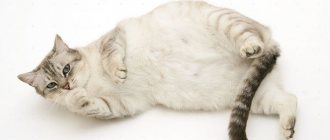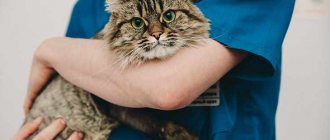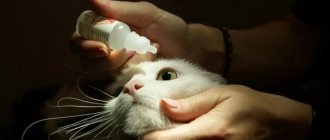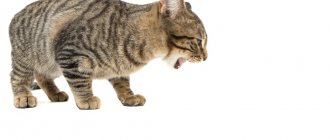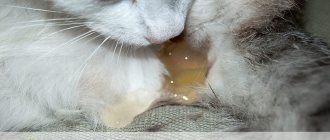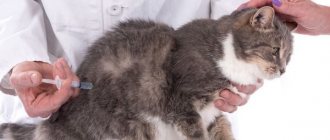The period of gestation of kittens is a trembling moment, both for the animal itself and for the cat owner. Experienced breeders can accurately determine when the process is going well and in which cases urgent veterinary intervention is needed.
Cat owners who do not have experience do not always know when to sound the alarm and what symptoms are not normal during pregnancy in cats.
One of the most alarming indicators is the presence of blood discharge from the animal’s loop during pregnancy. It is important to know when discharge is normal and when it is pathological.
Discharge at different stages of pregnancy
A cat's pregnancy lasts 9 weeks. It occurs in several stages:
- early – up to 3 weeks;
- fetal formation – up to 6 weeks;
- prenatal – up to 9 weeks.
A cat is expecting offspring.
Different secretions occur in each period. Kitties themselves are very clean and sometimes it’s hard to see her discharge. At the first stage of gestation, a light pink secretion may be released. During this period, the egg only attaches to the uterus. In the second stage of development, the transparent mucous part of the plug may separate as the cervix closes.
Important! If the discharge is bloody, then you should pay attention to this. They should not be confused with normal ones. There is a possible risk of miscarriage. A veterinarian's consultation is required.
At a later date, a secret may appear again, because the baby is due soon. Possible mucous scarlet secretion.
What to do if a pregnant cat is bleeding?
Bloody discharge during pregnancy indicates the development of pathology. Bleeding can be caused by placental abruption, kitten death, or uterine rupture.
If the event occurred before the 63rd day of pregnancy, and it is determined that the offspring has died, measures are taken to save the cat’s life, a cesarean section is performed.
In this case, castration is recommended, since there is a high probability of purulent damage to the reproductive organs.
When bleeding after the onset of contractions continues for more than 10 minutes, and blood loss is more than 2 tablespoons, you need to immediately take the cat to the clinic or call a veterinarian at home. If the birth went well, you should not be afraid of the release of blood clots mixed with mucus. Cleansing can last about two days.
What kind of discharge can there be?
A cat's discharge may include:
- simple;
Cat discharge: bloody, white, purulent
Acceptable light pink secretion at the beginning of pregnancy as a result of egg implantation.
- blood;
A variant of a pathological process or threat of miscarriage. In a pregnant cat, bleeding can be fraught with complications. But they are quite natural during contractions and pushing.
- dirty yellow color;
In this case, you need to monitor the cat’s behavior and see how many days she behaves unnaturally. Such discharge in a pregnant cat is usually nothing serious. They are formed as a result of waste products of babies.
With additional symptoms, this color indicates the release of pus from the loop. Perhaps an inflammatory process has begun in the uterus. Urgent treatment with effective drugs or termination of pregnancy is necessary.
- white.
A normal situation during the period of fetal formation. Amniotic fluid fills the uterine cavity, and the excess flows out.
X-ray of a pregnant cat
Important! In any doubtful situation regarding the health of a pregnant cat, it is better to consult a specialist who will perform an ultrasound or x-ray diagnostics.
Treatment for pathology
When contacting the clinic, the animal undergoes a series of tests, including ultrasound diagnostics and a clinical examination of the cat. Bleeding in cats poses a serious threat to the life of the pet. This is due to the fact that during the gestation of kittens, the uterus increases in size and is unusually supplied with blood.
In pathological processes (ruptures of the uterine walls, damage to large vessels), the animal quickly loses a large amount of blood and dies without timely help.
Depending on the established diagnosis, the specialist prescribes further treatment, including surgical intervention (if it is not possible to save the kittens) or maintenance therapy using anti-inflammatory drugs and antibiotics.
After any delivery, an animal with pathology needs maintenance therapy to quickly restore vitality.
Preventive measures during cat pregnancy to avoid the appearance of discharge from the loop imply organizing proper nutrition for the animal, both before and during pregnancy. It is recommended to protect the cat from hypothermia and infectious diseases (deworming and vaccination are an integral part of the prevention of animal health).
The manifestation of any signs of ill health of your furry pet is a reason to consult a veterinarian. It is important to make sure that the health of the cat and her babies is not in danger.
Dangerous diseases
Brown discharge from a cat's eyes
Bloody and green discharge with a specific odor in a cat during pregnancy always indicates a pathological process, which is why additional symptoms appear. The reasons may be different: inflammation of the reproductive system, placental abruption, fetal death, etc. In some cases, this indicates diseases that require urgent treatment.
Vaginitis
Inflammation of the vagina. A diagnostic sign is that the cat begins to lick itself quite often, hiding the discharge. This makes diagnosing the disease difficult. A mild form can be cured with douching, a severe form can be treated with antibiotics.
Endometritis
Inflammation of the uterus. It is caused by intrauterine infection, as a result of which the animal can give birth to weakened or premature babies, who sometimes even die. Acute endometritis, if left untreated, leads to the death of the cat. And as a result of chronic endometritis, hydrometra can develop. The secreted secretion itself can be of different shades, any consistency and smell.
Hydrometer
Accumulation of fluid, exudate, and secretions of the uterine glands in the uterine cavity. As a result, the uterus swells. Scanty or spotting discharge is possible. It often develops against the background of chronic endometritis. Emergency treatment is necessary, otherwise the cat may die.
Hematometer
Occurs in case of uterine injury or inflammation. Blood accumulation occurs. During pregnancy, a cat will have bloody discharge from the uterine cavity.
Pyometra
An inflammatory disease of the uterus, as a result of which pus accumulates in it. Due to hormonal imbalance or pathogenic flora entering the cavity, endometritis begins to develop.
Schematic drawing of pyometra in a cat
Pyometra occurs in two forms:
- open. The resulting pus leaves the uterine cavity to the outside. The owner can easily detect such departments and begin urgent treatment;
- closed. With this form, pus accumulates inside, thereby inflating the uterus. Diagnosing the disease in this case is much more difficult. It is necessary to observe the behavior of a pregnant cat. Lethargic and apathetic state, fever, loss of appetite, profuse thirst, the cat often begins to lick itself, often urinates, while breathing is heavy.
Prevention
In order for the process of bearing offspring in your animal to go smoothly, it is important to carry out preventive measures in a timely manner. Moreover, it is better to carry out some of them not at the moment when mating occurs, but throughout the entire life of the animal.
Monitor the animal’s health, get all the necessary vaccinations on time and select the right food, taking into account all the parameters. It would also be a good idea to have periodic checkups with a veterinarian.
After mating, you should carefully monitor the condition of the animal and pay attention to even the smallest changes.
- All the veterinarian's instructions must be followed very carefully.
- During pregnancy, you should protect your pet from cold, drafts and dampness.
- For mating, you should choose a healthy partner who has all the necessary vaccinations.
It is important that mucous discharge can also appear in a sterilized cat a short time after surgery. They have a slimy consistency and yellow color, but do not have a strong odor. If such discharge does not stop for a long time, then you should show your pet to a veterinarian, as inflammatory processes are likely to develop.
Proper care and following all doctor’s recommendations will help your cat have a normal pregnancy and give birth to healthy kittens. It is important for the owner only to pay attention to the condition of the pet, and everything else will happen by itself.
This article has been checked and approved by a veterinarian. Knyazeva Anna Vladimirovna, veterinarian in private practice, Moscow. more about the expert.
(you can vote for the article)
Tags: cat pregnancy, cat discharge, cat
- Related Posts
- The cat is tearing up the wallpaper: what to do?
- How and with what to properly comb a cat?
- What to do if your cat has white discharge from the uterus?
When any discharge appears, you should call a veterinarian
At the very beginning of pregnancy, immediately after mating, light pink discharge is possible. This is due to the formation of a mucus plug, part of which comes out. This is a homogeneous transparent mucus without a specific odor. This is a normal situation, there is no need to panic.
Necessarily! There are discharges, if detected, you should immediately contact a specialist.
Bloody, yellow, green, with brown clots, discharge with a specific odor - these are the symptoms that you need to pay attention to. May be accompanied by fever, restless behavior, lack of appetite, frequent drinking and urination, and cramping pain.
Important! Do not confuse blood in a cat before birth with pathological discharge.
Three days before delivery, the mucus plug comes off.
There may be stool coming out of the anus. There are completely different reasons and a different treatment.
Is bleeding before childbirth normal?
When contractions occur, blood is released, not light and not too dark, in a volume of no more than two tablespoons. Bleeding is not profuse and lasts up to 10 minutes. The discharge should not have an unpleasant odor or contain brown or green impurities.
Be sure to read:
Pregnant Sphynx cat: how to find out about the position, changes in behavior and appearance, how long they walk
Discharges colored in the following colors are considered dangerous:
- white;
- yellow;
- green;
- brown;
- scarlet.
The cause of the unpleasant odor is a bacterial process. Scarlet excreta is a threatening symptom indicating arterial bleeding.
Depending on the nature of the discharge, the veterinarian decides who to save: the mother or the offspring.
Preventive measures
Some discharge is a variant of a normal physiological process. To avoid the addition of pathological flora and subsequent inflammation, you need to follow a number of recommendations:
- strictly observe antiseptic conditions during childbirth;
- regular health checks with a veterinarian;
- Ultrasound of the uterus should be done periodically;
- when mating, carefully check the cat for the absence of genitourinary infections;
- do not postpone a visit to a specialist if you notice a different cat behavior with a specific secretion and smell.
Cat pregnancy is a process during which it is worth paying close attention to your pet. Unhealthy discharge in a pregnant cat is a reason to immediately contact a veterinarian. Timely treatment will help maintain the health of the pet and the life of the kittens in the womb.
Video
What should an expectant mother be wary of?
The second trimester is characterized by a large amount of discharge. Normally, they have a light white or yellowish tint, a uniform consistency, and no odor. Discharge becomes more abundant due to the fact that it is more difficult for the body to maintain normal microflora, compensatory mechanisms are launched.
However, the appearance of the discharge described below is not typical for a normal pregnancy:
- Brown. There is a risk of late miscarriage, premature birth and problems with the placenta.
- Greenish, gray. Indicate infectious processes of a purulent nature.
- White curdled ones. The microflora is disrupted and, as a result, thrush occurs.
If any unusual discharge occurs, you should consult a doctor.
Diagnostic measures
If suspicious discharge appears in a cat before or before birth, it is necessary to take the pet to the veterinary clinic as soon as possible, where it will be examined by a veterinarian. The doctor will determine the nature of the discharge, whether it is pus, blood, ichor or transparent white mucus. Pink discharge without other inclusions in the early stages of pregnancy is considered normal; if the cat feels well and is not worried, then there is nothing to worry about. It’s another matter when there is bleeding from the genitals, with blood flowing or dripping constantly, the animal feels bad, is worried, or, conversely, is lethargic and passive. Then a referral is given to the following diagnostic methods:
- general blood and urine analysis;
- microbiological examination of secretions;
- Ultrasound.
How to treat?
The owner needs to be close to the pet at such an important moment and monitor so that no complications occur.
Clear, light pink bleeding before childbirth is considered normal, so treatment is not required. The owner needs to monitor the pet’s condition, calm her down during childbirth, and do everything to ensure that the process ends safely. At the same time, during childbirth, it is important to pay attention to the nature of the amniotic fluid, color, and smell. If you have any suspicions, it is better to tell everything to the veterinarian, who will refer you for additional examination and, if necessary, prescribe restorative treatment.
In case of uterine abruption, when bloody discharge comes from under the tail, the doctor first of all takes into account the timing of pregnancy. In the later stages, constant monitoring is carried out, and comprehensive analyzes are carried out. Delivery usually occurs without complications unless the animal has other health problems. If abruption occurs in the first half of pregnancy, and the bleeding is profuse, there is no other choice but to artificially induce labor, since the cat may die.
No less dangerous than bloody discharge are purulent discharges, which are often the result of the death and decomposition of one or more fetuses. In such situations, the veterinarian prescribes effective antibiotics and other drugs to avoid complications. If the condition does not return to normal, the doctor will suggest a cesarean section or termination of the pregnancy to save the animal’s life. After surgical treatment or urgent induction of labor, long-term rehabilitation under the supervision of a physician will be required.
The cat's mucus plug came off
As a rule, the period of release of the mucus plug takes several hours. Having noticed a mucus plug, the owner should be on alert. The following symptoms may indicate the upcoming birth process:
- Showing attention to the genitals, swelling of the loop and change in its color. Under normal conditions there should be no discharge.
- Reduced animal activity. The pet prepares for the upcoming birth, becomes detached, and sometimes thoughtful. You cannot force a cat to be active.
- Loss of appetite. The cat refuses food and may be constantly thirsty.
- Specific stretching of the body, indicating the onset of contractions. This behavior means that the birth process has begun and the uterus is contracting.
In addition, a woman in labor, especially a firstborn, begins to meow loudly out of fear, trying to hide from prying eyes. It is recommended to close all hiding places and stop access to closets and closets for the cat.
It is important that the owner is always nearby, constantly petting the pet, talking to her in a gentle voice. It is forbidden to shout at an animal, even if it behaves inappropriately (for example, crawling under the blanket or ruining the sheets).
The onset of impending labor is also accompanied by the following symptoms:
- lowering of the abdomen - it takes on the shape of a pear;
- trips to the toilet become more frequent due to the pressure of the uterus on the bladder;
- release of the mucus plug;
- loss of water, accompanied by constant licking of the cat in the loop area;
- rapid breathing (shortness of breath).
The first baby appears after the onset of strong contractions for several hours.
Attempts that occur after contractions and last longer than 3 hours are considered pathological. In this case, you must urgently contact your veterinarian.
As a rule, prolonged labor in a pet begins to be accompanied by the appearance of an unpleasant odor. It is possible that the animal will need to undergo surgery.


